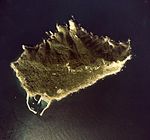Sacred Island of Okinoshima and Associated Sites in the Munakata Region
| UNESCO World Heritage Site | |
|---|---|
| Location | Munakata, Fukuoka Prefecture, Kyushu, Japan |
| Criteria | Cultural: (ii)(iii) |
| Reference | 1535 |
| Inscription | 2017 (41st Session) |
| Area | 98.93 ha (244.5 acres) |
| Buffer zone | 79,363.48 ha (196,111.4 acres) |
| Coordinates | 34°14′42″N 130°6′20″E / 34.24500°N 130.10556°E |
Sacred Island of Okinoshima and Associated Sites in the Munakata Region (「神宿る島」宗像・沖ノ島と関連遺産群), officially Sacred Island of Okinoshima and Associated Sites in the Munakata Region, is a group of sites in northwest Kyūshū, Japan, that was inscribed on the UNESCO World Heritage List in 2017, under criteria ii and iii.[1]
Background
The three Munakata kami are said in the Kojiki and Nihon Shoki to be daughters of Amaterasu, spawned upon the sun-goddess' consumption of giant swords.[2][3] Okitsu-Miya on the island of Okinoshima is part of the Shinto shrine complex of Munakata Taisha; no formal shrine buildings were constructed on the island; instead rock piles or yorishiro provided the focus for veneration.[4] Over 80,000 artefacts were ritually deposited at the site from the fourth to the tenth centuries.[1] These have been designated a National Treasure.[5][6] They include mirrors and bronze dragon-head finials from Wei China; gold rings and horse-trappings similar to those found in Silla tombs in Korea; and fragments of a glass bowl from Sassanian Persia.[2] The Munakata clan (宗像氏), powerful local rulers, controlled the route to the continent and "presided over the rituals".[1][2] The many kofun or tumuli in the area are believed to be their burial ground.[1]
Component Sites
| Site | Municipality | Comments | Image | Coordinates |
|---|---|---|---|---|
| Okinoshima 沖ノ島 Okinoshima |
Munakata | the island's primeval forest is a Natural Monument and the island a Wildlife Protection Area[7][8] |  |
34°14′48″N 130°06′15″E / 34.24676121°N 130.10412967°E |
| Munakata Taisha - Okitsu-Miya 宗像神社境内 沖津宮 Munakata Jinja keidai - Okitsumiya |
Munakata | on the island of Okinoshima; Tagori-hime (田心姫神) is enshrined; the precincts of Munakata Taisha are an Historic Site[9] |  |
34°14′29″N 130°06′14″E / 34.241448°N 130.103853°E |
| Munakata Taisha - Nakatsu-Miya 宗像神社境内 中津宮 Munakata Jinja keidai - Nakatsumiya |
Munakata | on the island of Ōshima; Tagitsu-hime (湍津姫神) is enshrined |  |
33°53′49″N 130°25′56″E / 33.896992°N 130.432222°E |
| Munakata Taisha - Hetsu-Miya 宗像神社境内 辺津宮 Munakata Jinja keidai - Hetsumiya |
Munakata | on the mainland of Kyūshū; Ichikishima-hime (市杵島姫神) is enshrined; the ICP honden and haiden date respectively to 1578 and 1590[10][11] |  |
33°49′52″N 130°30′52″E / 33.831089°N 130.514347°E |
| Tsuyazaki Tumulus Cluster - Shinbaru-Nuyama Tumulus Cluster 津屋崎古墳群 新原・奴山古墳群 Tsuyazaki kofun-gun - Shinbaru-Nuyama kofun-gun |
Fukutsu | On the mainland, five keyhole-shaped tumuli, one square tumulus, and 41 round tumuli within sight of the island of Okinoshima, believed to be the 5th - 6th century graves of the Munakata clan chieftains |  |
33°48′59″N 130°29′16″E / 33.816379°N 130.487752°E |
Original submission
The following sites were included in the original nomination, but were excluded from the final inscription:[12][13]
See also
- List of National Treasures of Japan (archaeological materials)
- Yorishiro
- World Heritage Sites in Japan
References
- ^ a b c d "Sacred Island of Okinoshima and Associated Sites in the Munakata Region". UNESCO. Retrieved 10 July 2017.
- ^ a b c Brown, Delmer M, ed. (1993). The Cambridge History of Japan I: Ancient Japan. Cambridge University Press. pp. 312–6. ISBN 0-521-22352-0.
- ^ Aston, W.G. (1972) [1896]. Nihongi: Chronicles of Japan from the Earliest Times to A.D. 697. Vol. I. Tuttle. p. 37. ISBN 0-8048-0984-4.
- ^ Watanabe Yasutada (1974). Shinto Art: Ise and Izumo Shrines. Weatherhill. p. 125. ISBN 0-8348-1018-2.
- ^ "福岡県宗像大社沖津宮祭祀遺跡出土品" [Excavated Artefacts from Rites at Munakata Taisha Okitsu-no-Miya] (in Japanese). Agency for Cultural Affairs. Retrieved 28 June 2012.
- ^ "伝福岡県宗像大社沖津宮祭祀遺跡出土品" [Excavated Artefacts attributed to Rites at Munakata Taisha Okitsu-no-Miya] (in Japanese). Agency for Cultural Affairs. Retrieved 28 June 2012.
- ^ "沖の島原始林" [Primeval Forest of Okinoshima] (in Japanese). Agency for Cultural Affairs. Retrieved 28 June 2012.
- ^ "国指定沖ノ島鳥獣保護区" [Okinoshima National Wildlife Protection Area] (in Japanese). Ministry of the Environment. Retrieved 28 June 2012.
- ^ "宗像神社境内" [Munakata Jinja Precinct] (in Japanese). Agency for Cultural Affairs. Retrieved 28 June 2012.
- ^ "宗像神社辺津宮本殿" [Munakata Jinja Hetsumiya Honden] (in Japanese). Agency for Cultural Affairs. Retrieved 28 June 2012.
- ^ "宗像神社辺津宮拝殿" [Munakata Jinja Hetsumiya Haiden] (in Japanese). Agency for Cultural Affairs. Retrieved 28 June 2012.
- ^ "宗像・沖ノ島と関連遺産群" [Okinoshima Island and Related Sites in Munakata Region] (PDF) (in Japanese). World Heritage Promotion Committee of "Okinoshima Island and Related Sites in Munakata Region". pp. 5f. Retrieved 28 June 2012.
- ^ "Okinoshima Island and Related Sites in Munakata Region" (PDF). World Heritage Promotion Committee of "Okinoshima Island and Related Sites in Munakata Region". pp. 6f. Archived from the original (PDF) on 12 December 2013. Retrieved 28 June 2012.

